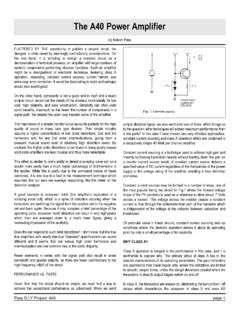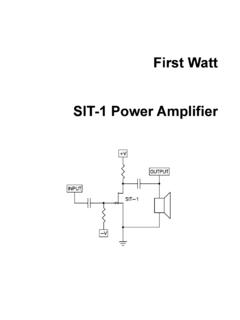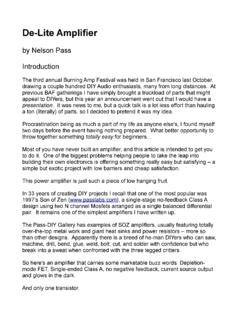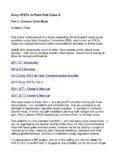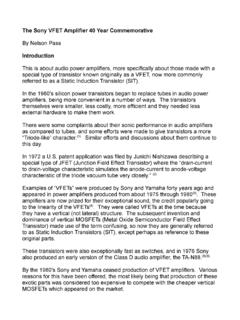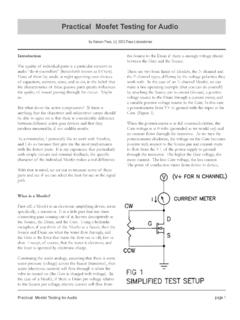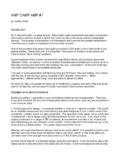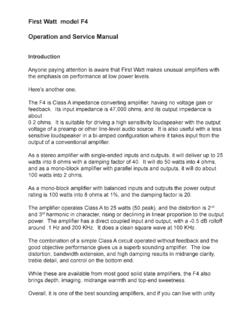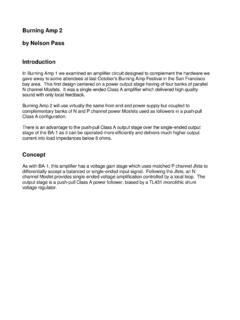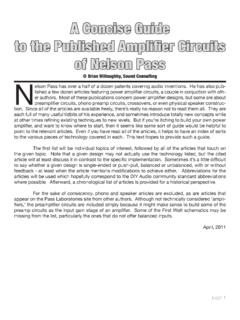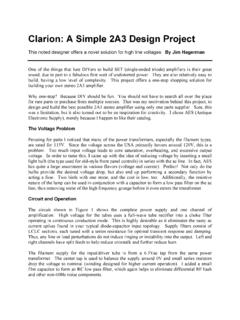Transcription of AJ Power Amplifier - FIRST WATT
1 FIRST watt Aleph J Power Amplifier It s been about 9 months since the introduction of the FIRST watt F1, and a few weeks since the introduction of the F2. Normally I would wait a while before introducing another Amplifier , but it seems that the majority of potential customers request a more regular kind of Amplifier , something that can drive an ordinary loudspeaker - Just a few more watts and some damping . Meanwhile, it s been about 13 years since I designed the Aleph 3, and I have such affection for that series that I revisited the design. I wanted to better address the customer who owns high efficiency loudspeakers and maybe a tube preamp. From my experience with small amplifiers I know that this person values the naturalness and musicality of the Amplifier s sound over specifications. The logical alternative is a high quality tube amp. Am I trying to emulate a tube Amplifier ? No, but I make use of some of the principles that make tubes sound good - simplicity and linearity.
2 Toward that end, I wanted to simplify the signal path and reduce negative feedback without giving up on the measured performance. The Aleph J has about 15 dB less negative feedback than the original and achieves comparable distortion, bandwidth, and damping figures. It also has about 15 dB less noise. Those of you with delicate tube preamps will be happy to see a 242 K ohm input impedance with vanishing capacitance. I consider it the best of the Aleph series. _____ Nelson Pass The Aleph J carries on in the tradition of the Pass Labs Aleph series, combining those elements that were particularly right about the Aleph 3 and 30, and re-thinking those areas open to improvement. Unlike its FIRST watt predecessors the F1 and F2, the Aleph J is a voltage source Amplifier a regular sort of Amplifier like the ones you already know and love. There are differences between the Aleph J and its predecessors: 1) Improved Power supply filtration with about 20 dB less voltage ripple 2) Reduced gain on the active current source, giving better overall performance into 8-16 ohm loads 3) Input stage using high quality matched JFETs 4) Much higher input impedance and vanishing capacitance 5) 15 dB less negative feedback.
3 6) Even greater stability, operating without lag compensation 7) 15 dB less noise 8) No electrolytic capacitor in the signal path Some things have remained the same the Aleph J has the same basic 2-stage topology and uses output MOSFETs operating in single-ended Class A mode. It s distortion character is still 2nd harmonic, and it s sound is still natural and liquid. It is still very reliable. I don t know of a load that can damage it. I built this Amplifier myself. No, I didn t extrude the aluminum or etch the circuit boards, but I assembled, tested, aged, and listened to each one. The initial setup of the Amplifier is very straight-forward. Place the Amplifier in a well-ventilated location, as it draws 200 watts during operation and requires as much opportunity to cool itself as possible. You should be able to put your hand on the heat sink during operation. If you can't do this for 5 seconds or so, it needs better ventilation.
4 On the front panel there are two blue LED lights, one for each channel, indicating Power to the channel. On the rear panel you will find pairs of RCA inputs, balanced XLR inputs, speaker outputs, a fuse holder, and AC Power receptacle, and on/off switch and a label. The label will indicate a serial number and also what AC line voltage the Amplifier is set for. For 120 VAC, the fuse value is 3AG slow blow 4 Amps. For 240 VAC, the value is 2 amps. If you are using the single-ended RCA inputs, make sure that the jumper is present between pins 1 and 3 of the balanced XLR connector, or you won t get any gain. I'm assuming that you know how to attach the speaker cables to the 5 way output connectors provided. Make all the connections with the Amplifier Power switch in the OFF position to avoid unpleasant noises or damage to fragile loudspeakers. With everything connected up and the source equipment powered up FIRST , you can proceed to turn on the Power switch to the Amplifier .
5 Turn-on and turn-off thumps and noise are small in this Amplifier , and should not present a hazard to delicate drivers. The Amplifier requires about 1 hour of operation to reach normal operating temperature, and this warm-up time is appropriate for the most critical listening, but is not otherwise an issue, as the performance difference between 5 minutes and 60 minutes is very marginal. I do not personally see a reason to run the Amplifier all the time. Now the following is for your protection, so pay attention: Do not defeat the AC line Earth ground connection on the Amplifier Power cord. It provides an extra barrier to prevent potential shock hazard. Do not replace the fuse with a type other than specified. Do not operate the Amplifier outside in the weather, or in and around water or anything resembling water. If you spill a drink in the Amplifier or if your dog/cat/child urinates on it, turn it off immediately, unplug it, and do not operate it until checked by a qualified technician.
6 If something gets loose or rattles around inside or smells funny, turn it off and get a qualified technician to look at it. If you can t touch the heat sinks for 5 seconds or so, it might be a ventilation problem, but it might be something else. Consult FIRST watt or a qualified technician. There are no user serviceable parts inside. Do not open the Amplifier , and if you do anyway, don t operate it with the cover off. There are hazardous voltages inside. If you need to change the operating AC voltage, consult the factory or a qualified technician. If you have a problem, contact me. I am much happier fixing anything myself so that I can be certain that it s done properly. My experience is that most repair efforts done by amateurs in the field do more harm than good. To obtain service or get free advice: of the nominal specifications: Measured at 120 V AC with an 8 ohm load: Input Impedance 242 Kohms (RCA input) Damping Factor 20 Output Power 25 watts @ 1% THD 1 KHz 30 watts @ clipping Gain dB Input for 25 watts output volts Maximum output voltage +/- 21 volts Maximum output current +/- amps Frequency response - 3 dB @ 6 Hz, 80 KHz Noise 100 uV unweighted, 20-20 KHz Power consumption 200 watts Fuse 3AG slow blow, 4 A (120 VAC) 3AG slow blow, 2 A (240 VAC) Warranty: Parts and labor for 3 years, not covering shipping or consequential damages.
7 Copyright 2005 General Amplifier General Amplifier Inc. PO BOX 7607 RENO NV 89510-7607 DISTORTION VS Power @ 1 KHZ DISTORTION VS FREQUENCY @ 1 watt

